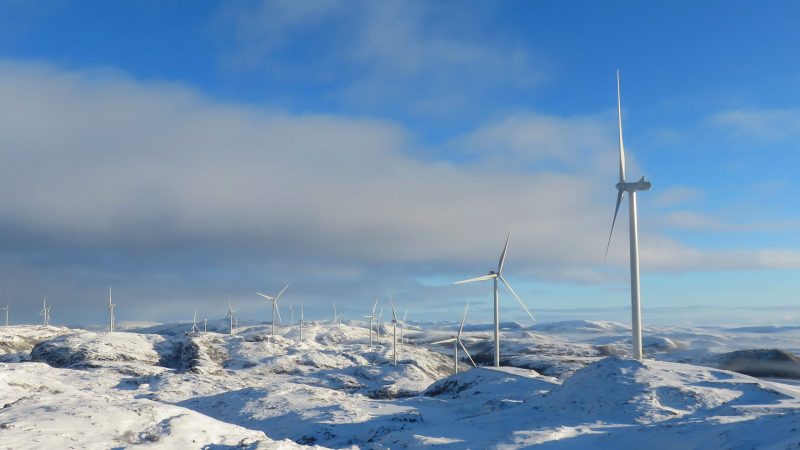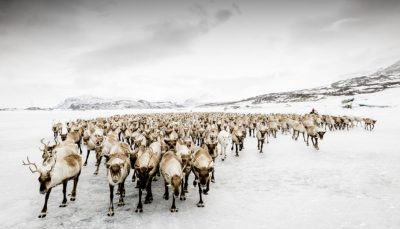Sami and environmental activists ended their blockades of several Norwegian government ministries on Friday, after securing official promises that huge turbines generating wind power on the Fosen Peninsula will no longer be allowed to violate their human rights to herd reindeer in the area. The power itself is valuable and needed, though, and no one knows how the bitter conflict between an important source of renewable energy and the traditions of Norway’s indigenous people will be resolved.

The 151 turbines at Fosen in Trøndelag form Norway largest wind power facility, and have become a major source of electricity for both households and industry. They also offer an alternative to fossil fuel, at a time when the oil-producing nation needs to cut its carbon emissions.
Fosen is also, however, an important grazing area for reindeer that allows local Sami to continue centuries-old traditions handed down from generation to generation. The huge turbines disturb the reindeer, and Norway’s own Supreme Court ruled in October 2021 that they were, as the Sami had claimed for years, erected illegally because they violate the Samis’ human rights.
This has posed a huge dilemma, pitting Sami interests against the need for “green” energy and huge investment in the Fosen facility. The government is being harshly criticized for failing to act on the Supreme Court decision until protest demonstrations broke out in Oslo last week. After seven straight days of blockades around ministries and confrontations with police and Oil & Energy Minister Terje Aasland, the government finally issued a long overdue apology to the Sami people on Thursday and vowed that their human rights would be restored.
The demonstrators and several Sami reindeer herders invited for breakfast with Prime Minister Jonas Gahr Støre on Friday want the turbines to be taken down and the nature restored. They also seem far more interested in their traditional grazing rights than in any financial compensation for loss of livelihood and income.
Others have pointed out, however, that the income from the sale of reindeer meat amounts to only a few hundred-thousand kroner a year, compared to the billions generated by the wind turbines. “It would be crazy to tear them down,” Lars Ove Skorpen, head of renewable energy investments for Oslo-based Pareto Securities, told newspaper Dagens Næringsliv (DN) this week, when the demonstrations put the dilemma at the top of the news. “We must find solutions. If that means the turbines will be shut down at certain times, when reindeer approach, I don’t know,” he said, adding that “the sores” they’ve created on the natural beauty of the area (including roads connecting the turbines) are “already a fact.”

Since the Sami have grazing rights in large areas of Norway, Skorpen worries that the Supreme Court decision means there’s now much less area available for new and important renewable energy projects. “This all came as a big surprise to investors in wind in general,” he told DN, and will make it much harder for Norway to meet its climate goals.
“It’s a very demanding situation,” agrees Åslaug Haga, a former Oil & Energy minister herself who now leads the alternative energy organization Fornybar Norge. “We’re going to struggle (with meeting climate goals) if we can’t use the wind power capacity at Fosen,” she told DN. She thinks Prime Minister Støre will resist shutting down the company operating many of the turbines, Fosen Vind, and in which the state controls 52 percent through its wholly owned power company Statkraft.
Oil & Energy Minister Aasland has also said that the goal is to keep the turbines operating in the hopes they can coexist with the reindeer. He promised the president of the Sami Parliament, though, that Sami rights will be respected, whatever that ultimately entails.
The government’s apology for taking so long to tackle the issue reduced friction between the two sides, but demonstrators including their leader Ella Marie Hætta Isaksen have lost confidence in Aasland and Støre because of how they “all but ignored” the issue until being forced to confront it this week. Isaksen wants a ministry other than Oil & Energy to take over responsibility for finding a solution to the conflict, because of inherent conflicts of interest. Since Oil & Energy is responsible for the state’s stake in the Fosen wind turbines, it may be unlikely to go along with shutting them down, which is still what the reindeer herders want.
Several other political parties in Parliament agree, even the Greens Party that strongly supports alternative energy projects and is committed to meeting climate goals. The Reds and, perhaps most importantly, the Socialist Left Party (SV), also fail to see many options to shutting down Fosen. Norway’s minority government coalition relies on SV for a majority in Parliament.
The Labour-Center government, however, would likely get support from either the Conservatives or the right-wing Progress Party to keep the wind turbines turning. Both have remained unusually quiet during the past week of demonstrations and conflict, perhaps because it was during their own coalition government that the so-called “wind park” actually opened and was expanded.

They in turn would have the support of even Norway’s “greenest” investor and wealthy businessman, Jens Ulltveit-Moe. He’s also a committed climate activist and has directed all his investments in recent years in a green direction. He’s also a board member of the Greens Party, but he told DN this week that it would be a “tragedy” if the Fosen wind power project is shut down.
“My main priority is to halt climate change,” Ulltveit-Moe said, “and I think we must tolerate scars on the nature, because if global warming continues, we’ll see even more damage to the environment, much worse than these wind power projects cause.”
With all respect to the Sami, he also thinks they must also sacrifice certain traditions or lifestyles out of regard to greater good. “To tie up so much land area in Norway so that 3,000 reindeer herders can produce (meat) is not rational,” Ulltveit-Moe to DN. He said he respects the Supreme Court decision, but thinks the Sami should be offered and accept some adequate form of compensation for yielding grazing rights.
He’s thus on a collision course within his own party, but is willing to take on the fight. “When we see the need to produce electricity in order to reduce (fossil fuel) emissions, I think it’s correct to build wind power and other renewable energy projects,” he said. That can include diverting waterways and waterfalls to produce more hydroelectric power, another source of conflict in Norway.
Even though the Sami also have great respect for the environment, Sami Parliament President Silje Karine Muotka thinks Ulltveit-Moe is portraying himself as “a climate fundamentalist” willing to weaken democratic processes or even the rule of law. “That’s a dangerous view on society that I hope few responsible politicians support,” she told DN.
The most important thing now, most agree, is that the process for finding solutions to the conflict over Fosen proceeds as quickly as possible. No one seems to know whether reindeer can learn to live with turbines whirring overhead. Aasland has promised to listen most to the reindeer herders, while also collecting other relevant information.
One thing is sure: If Isaksen and her fellow demonstrators don’t see “real progress” by the government aimed at resolving the issue, they’ll be back blocking ministry entrances. They ended eight days of demonstrations with a large gathering in front of Parliament Friday morning and in front of the Royal Palace, prompting all the government ministers to drive up to the rear entrance of the palace for their weekly Council of State with King Harald V, long known as a sympathetic supporter of Sami interests.
newsinenglish.no/Nina Berglund

